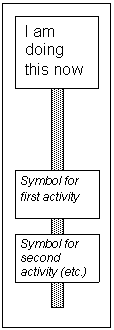Search
User login
Topic “Personal, Social and Emotional”
Activities to develop early turn taking skills
| Activity/strategy name and materials required | How to do the activity | Key principles for doing the activity and comments |
|---|---|---|
| Ball Roll - a ball |
| To extend this activity, you could add extra people to roll the ball to (small group).
|
Developing turn taking using sensory toys
| Activity/strategy name and materials required | How to do the activity | Key principles for doing the activity and comments |
|---|---|---|
| Sensory Suitcase Use a small box or bag to collect toys which target different sensory areas e.g. Auditory (noisy toys) toys (rattles, squeakers, shakers, musical items, drums etc.) Visual toys (flags, streamers, Slinkies, spinners, bubbles, flashing items, torches, pop-up toys, windmills etc.) Tactile toys (toys that feel different) (balls of different textures to squeeze, brushes of different textures to be tickled with, materials e.g. velvet, sandpaper, feathers, pots of rice/macaroni to feel, Play dough to squeeze/cut ) Scented toys (play dough, Plasticine, some rubber toys) | 1. Collect some toys from each of the sensory categories described. 2. Store the toys in a container which you use only for this specific activity and is otherwise stored away from children. 3. Find a quiet comfortable place to work either at a table or on the floor. Try to make sure the child cannot easily run off or get distracted. 4. Make a show of shaking the suitcase and seeming happy about the approaching activity. 5. Take out two toys from different sensory categories and place them in front of the child - note which category of item the child chooses/reaches for and put the other item back in the suitcase. 6. Allow the child a short time to enjoy the item chosen then say 'Your name's turn' (e.g. "Mary's turn") and gently but firmly take the item for your turn. 7. Use the toy for a short time then offer it the child again. Say 'Child's name's turn'. 8. Repeat a few times but stop before the child gets bored. 9. Start the process again by offering the child a choice of toys from two different sensory categories and then follow the turn taking routine. 10. Continue with the activity for approximately 10 minutes - stop before the child gets bored. 11. Store the sensory suitcase in a secure place until the next session.
| These activities are based on a child's sensory preferences. Some children love visual toys but are frightened of noisy (auditory) toys. Accept these preferences and work with the sensory areas the child is comfortable with. Some children will choose some kinds of noisy toys and reject others or show fear when presented with others. Some children are frightened of feathers but love being tickled with a shaving brush. Experiment and observe! Sensory preferences can change over time as well! Keep the activity fun and show that you are enjoying it too! Make the activity time limited so that it stays special. Do the activity regularly and change the items used from time to time. |
| Create Colourful Patterns Use a selection of the following: Paint pots and brushes, felt tips, computer painting programme, pots with different coloured bits of paper to stick and a sheet of paper. | ||
| Messy Play Use, for example, one of the following sets of items: Sand tray with spades, pots etc. Water tray with pots, sieves, pourers etc Rice tray with pots and pourers etc |
Use a visual timetable
| Activity/strategy name and materials required | How to do the activity | Key principles for doing the activity and comments | |
|---|---|---|---|
| Using a visual timetable Home made visual timetable with 'finished' box or envelope and Velcro strip. Set of laminated symbols for timetable activities e.g. 'swimming', 'maths', 'carpet time' with scratchy Velcro on the back. You can create symbols cards in PowerPoint with the Commtap Symboliser. | 1. Make a long cardboard strip approximately 10cm wide and 60cm long. Attach a 'FINISHED' box or plastic envelop at the bottom of the strip. 2. Stick a strip of soft Velcro along the centre of the long laminated strip e.g.
3. Arrange symbols of the activities a child will cover for - say - a morning down the Velcro strip. 4. Just before an activity starts help the child put the relevant symbol into the 'I am doing this now' area at the top of the laminated strip. This shows the child what to expect to happen now. 5. When the activity is over help the child remove the symbol for the 'I am doing this now' area and post it into the 'FINISHED' box or envelope. Help the child take the next symbol and put it into the 'I am doing this now' area etc. | This technique helps children understand what is going to happen during the day. Use it with children who are anxious about change or find understanding class routines difficult. It is best to set up a visual timetable before the child comes into school and to set it up for a limited period say from arrival until the first play and then from after play until lunch and then a final set up for the afternoon period. Children sometimes try to alter the timetable to suit themselves e.g. putting play up near the top! This is not allowed! Only the adult in charge can change the order on a visual timetable. If following the set timetable for a given period is very difficult for a child you can make it easier by shortening the time a child must spend on each activity - but each activity must be done a little bit. You can try with just two activities (now/next) see the now/next visual timetable activity below. | |
| Now/next visual timetable "Now /next" visual timetable with 'finished' box or envelope and Velcro strip. Set of laminated photos for timetable activities e.g. 'story', 'outside', 'carpet time' with Velcro on the back. | If the child is resistant to some of the activities it's important to use clear consistent language e.g."first story, then sand". Being able to see a motivating activity coming up may mean that the child is happier to engage in less motivating activities. |
able to join in action songs with a group of children
| Activity/strategy name and materials required | How to do the activity | Key principles for doing the activity and comments |
|---|---|---|
| Old MacDonald Pictures of animals A good singing voice!! | Children sit in a circle and start to sing. After, "and on that farm he had a......" a child is chosen to choose a picture and sign the animal. Group continues to sing. Next verse a different child chooses an animal | Always encourage the child to sign the animal name alongside the other children. Ask the child "What's that?" when they choose the animal picture so the child is given an opportunity to spontaneously sign the animal. |
| Wheels on the bus Card with prompts for actions (optional) | Child can point to the card or do an action to indicate which verse to sing next. Give choices, "Shall we sing wipers or wheels next?" etc. | |
| If you're happy and you know it Card with prompts for actions: clap/stamp etc. (optional) | Child can point to the card or do an action to indicate which verse to sing next. Give choices, "Shall we clap or stamp next?" etc. |
Support Commtap to keep it online
Thank you for visiting Commtap.
Please read this message as it is extremely important.
- Visitor donations mean we can continue to host over 1,000 free activities to support speech, language, and communication development.
- Visitor donations mean we can continue to provide free resources to address a wide range of communication needs, including limited speech or language, interaction challenges, and needs associated with conditions such as developmental language disorder, autism, and cerebral palsy.
- Visitor donations mean we can continue to provide resources to support the work of speech and language therapists, teachers, teaching assistants, parents, and carers.
- Visitor donations mean we can continue to provide the free key word sign dictionary (bks.org.uk) which has over 2,000 Makaton and Signalong signs.
We know that not everyone is able to afford to pay to access these resources, however, if you can, please make a donation to keep the site going.
Thank you
Google ads on this page are provided by Google Adsense - and their presence does not imply any endorsement by Commtap. Report a problem with an ad on this page. Log in (for free) to avoid seeing Google ads.



